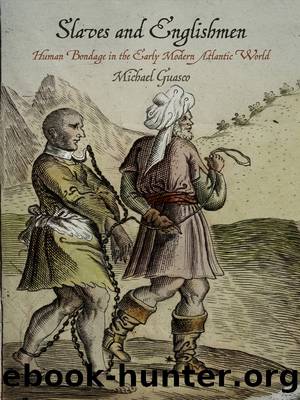Slaves and Englishmen by Michael Guasco

Author:Michael Guasco [Guasco, Michael]
Language: eng
Format: epub
Tags: History, Americas (North; Central; South; West Indies), Social Science, Slavery
ISBN: 9780812245783
Google: 7opwAgAAQBAJ
Publisher: University of Pennsylvania Press
Published: 2014-02-14T16:06:51+00:00
CHAPTER 6
______________
Slavery before âSlaveryâ in Pre-Plantation America
âwee are naturally inclinâd to love neigros if our purses would endure it.â1
Nobody was particularly interested in Jamaica in the 1650s. As a result of high mortality rates among Indians in the aftermath of the conquest, slave raiding, and Spanish indifference, barely 1,500 people could be found on the island at this time and most of them were huddled around the city of St. Jago de la Vega, a few miles inland from the southern coast. The Spanish reaped few benefits from Jamaica, beyond using it as a place to raise cattle and produce hides for local and foreign markets.2 European interlopers had occasionally raided the island during the preceding century, but everyone knew there were greater rewards to be found in other places, like Cuba and Hispaniola. However, as a result of Oliver Cromwellâs âWestern Designââa grand imperial plan to destroy Spainâs colonial empire in order to achieve both the economic and geopolitical ambitions of England and, perhaps, to help usher in a new age of Protestant ascendancy in the AmericasâJamaicaâs importance changed dramatically. In 1655, the English sent an expeditionary force to invade and capture Hispaniola from the Spanish Empire and begin the process of Anglicizing the New World. Their efforts ended disastrously and the English survivors were forced to lick their wounds on the coast of the ill-regarded but, as it turned out, lightly defended island of Jamaica. In just a few years, Spain would recognize English authority in Jamaica. As unexpected as this turn of events may have been, it laid the groundwork for the long-term expansion of Englandâs sugar industry in the eighteenth century. In the short run, however, the English takeover of Jamaica proved to be a valuable opportunity for the northern Europeans to engage African peoples in the Americas and to experiment anew with racial slavery.3
The English conquest of Jamaica began simply, with a formal Spanish surrender in 1655, but it dragged on for nearly six years as the remnants of the local Spanish population, runaway slaves, and new invasion forces from other Spanish colonies contested English authority. Not until 1661 would Spain formally cede the island to the English. Beginning in 1656, though, English immigrants/invaders came to establish plantations along Jamaicaâs southern coast, but high mortality rates on the island ensured that the English population would remain low.4 Although there were serious difficulties, English settlers did their best to transplant English laws and institutions into Jamaican soil and began the construction of settler societies that mirrored existing West Indian settlements.5 Getting rid of Spain and all things Spanish was certainly one objective of the Protestant English invaders, but early Anglo-Jamaicans (like their forebears in other English colonies) willingly adapted themselves to the exigencies of a decidedly non-English Atlantic world, particularly when dealing with the resident African population.6
Many of the first Africans in Englandâs new colony were runaway slavesâMaroonsâwho resisted the English invaders just as they had resisted the Spanish before them. If, as Governor Edward DâOyley
Download
This site does not store any files on its server. We only index and link to content provided by other sites. Please contact the content providers to delete copyright contents if any and email us, we'll remove relevant links or contents immediately.
| Africa | Americas |
| Arctic & Antarctica | Asia |
| Australia & Oceania | Europe |
| Middle East | Russia |
| United States | World |
| Ancient Civilizations | Military |
| Historical Study & Educational Resources |
Machine Learning at Scale with H2O by Gregory Keys | David Whiting(4199)
Never by Ken Follett(3800)
Fairy Tale by Stephen King(3226)
The Man Who Died Twice by Richard Osman(2998)
Oathbringer (The Stormlight Archive, Book 3) by Brandon Sanderson(2902)
Will by Will Smith(2795)
Rationality by Steven Pinker(2291)
The Dark Hours by Michael Connelly(2246)
Can't Hurt Me: Master Your Mind and Defy the Odds - Clean Edition by David Goggins(2230)
Friends, Lovers, and the Big Terrible Thing by Matthew Perry(2126)
The Dawn of Everything: A New History of Humanity by David Graeber & David Wengrow(2123)
Principles for Dealing With the Changing World Order: Why Nations Succeed and Fail by Ray Dalio(1974)
HBR's 10 Must Reads 2022 by Harvard Business Review(1782)
A Short History of War by Jeremy Black(1764)
Go Tell the Bees That I Am Gone by Diana Gabaldon(1690)
515945210 by Unknown(1602)
A Game of Thrones (The Illustrated Edition) by George R. R. Martin(1595)
Kingdom of Ash by Maas Sarah J(1529)
443319537 by Unknown(1472)
